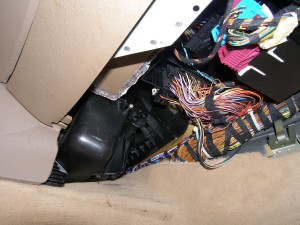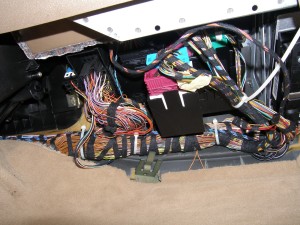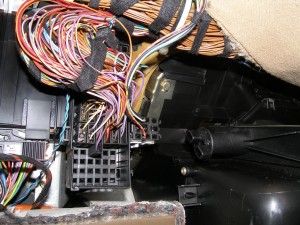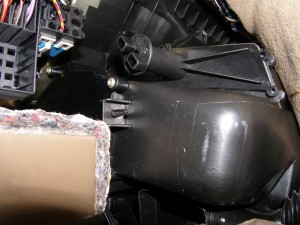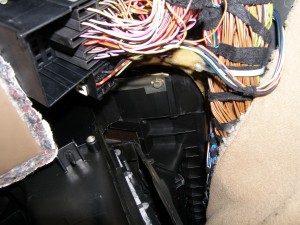Introduction
All modern BMWs filter interior air through a replaceable fine particulate filter called a "microfilter". On the latest vehicles, the microfilter(s) are located in easy-to-reach spots under the hood and take only a minute or two to replace. Since a microfilter was an afterthought on the E36, however, it's wedged in the only place BMW could think to put it -- on the upstream side of the evaporator coil. In other words, it's under the dash in a really inconvenient location.
The microfilter is aptly named, as it is sufficiently dense to catch more than just large leaves, twigs and bugs. The before/after shot above demonstrates how well it does its job. For this reason, if left installed beyond its recommended replacement interval it can contribute to odd smells in the interior, and if left in place beyond all reason, it can clog and thereby reduce the effectiveness of the car's HVAC system. BMW recommends it be replaced at intervals of 15K miles, and based on my experience that's perfectly reasonable. The procedure to replace the filter is very simple in principle, but tedious and annoying in practice. This article aims to explain my experience doing this job for the first time.
Notes and Warnings
- Disclaimer: I'm not a BMW technician, but I play one online. This article is provided freely for entertainment purposes only and is not intended to be instructional in nature. Use of the information in this article is entirely at your own risk. See my site's Terms of Service for more information regarding the usage of content provided by this site
- This job is a royal pain in the ass (and back, for that matter). It requires you to work on your head wedged into a small space and your back contorted over the seat and into the footwell. If you have any issues with back pain or claustrophobia, stop reading and take your car to a technician.
- Warning: The task requires you to move the core wiring harnesses around a bit and may involve work in close proximity to the passenger airbag trigger wires. Don't be ham-fisted with the harness or you may create a wiring fault that may be difficult to impossible to find without the assistance of a technician.
Prerequisites
- BMW Microfilter, Part #64119069895
- #2 Philips screwdriver with 4-6" shank
- 8mm six point socket with 6" fixed extension
Which way is up?
Most of the pictures on this site are taken from the perspective of being upright. Some of the pictures in this article were taken while I was on my back in the passenger foot well and they have not been rotated or otherwise modified so that you can get a true sense of how things will look when you're in that position.
Procedure (Abandon hope all ye who enter here)
The procedure to replace the microfilter is very simple in principle, and annoying in reality. I read a lot of other DIY microfilter articles online but they were long on text and short on pictures. Whatever pictures I found were tiny and blurry. This made it very difficult for me to wrap my head around this procedure. For this reason, this DIY will be heavy on pictures.
I had the advantage of once seeing my technician do this -- quickly, I might add. The BMW TIS and some of the online tutorials, including one by Mann, the OE filter manufacturer, insisted I had to remove the glove box to do this job, but my technician did NOT do this. He did everything by removing the dashboard trim panel that forms the top of the passenger footwell. The panel I'm referring to contains the footwell lighting and has holes for the HVAC duct work.
Although that I knew removal of the glove box would give me a lot more clearance to move stuff around, I was driven to do this exactly the way my technician did it simply to prove to myself that I could do it. I would not necessarily recommend you do it this way (or any other way, for that matter), but I'm here to tell you you do NOT need to remove the glove box on a 1998 328is to do this job.
The procedure to replace the microfilter is as follows:
- Remove the upper ("ceiling") trim panel in the footwell. There have been a few different designs of this trim panel, apparently, but mine is the latest and is held in place by two screws on the rear of the trim piece and a slot in the top portion of the kickpanel. The idea is to remove the screws, pull the rear of the trim panel down enough to get your hand in to reach the back of the footwell light and disconnect it, and then slide the trim piece toward the rear of the vehicle to remove it. I strongly recommend you put the screws with the trim panel and take them somewhere safe, like on a table in your work area. You don't want to drop those screws (yes, I'm speaking from experience here, but fortunately I found them before I pulled all my hair out).
- Remove the footwell duct work. This is shaped like a double "L". All of the E36's have been out in the field for so long at this writing that I highly doubt any original microfilters exist, but if yours has never been changed, removal of the duct work may take a bit more work because it is fastened in place with a plastic rivet that is only accessible from above. You have two choices here. You can take out the glove box to gain access to the rivet or just do what everyone else does, including my 30 year BMW technician -- wrestle the duct around until the rivet snaps. This may crack or break the boss of the duct that connects to the rivet, but it's not that bad, really. The duct is structured in such a way that it's not perfectly leak proof anyway and it doesn't need to be. The only thing I'd say is that if your duct breaks in half, you should probably replace it because you want the air in the footwell, not blowing across the vehicle's wiring harness.
- Move the wiring harness to provide the clearance necessary to R&R the microfilter. The area under the glovebox is host to an airbag assembly and the vehicle's wiring harness, which consists of several connection blocks fastened to each other, and then fastened to the vehicle as a unit. The connection blocks prevent of removing the microfilter from its slot, so at the very least one of the blocks must be moved out of the way to provide the necessary clearance. Some have been successful at unclipping the block closest to the microfilter slot, but I was unable to release it from the others. I was forced to move the entire wiring assembly by removing the three (3) 8mm bolts holding it up. Two of the screws are oriented vertically and are located in the compartment toward the front of the vehicle, while the third is oriented horizontally near the rear of the compartment. Check the pictures for more, and note that those pictures are taken from the same perspective you'll be in when you do this job (upside down in the footwell with your head facing the front of the car).
- Find the microfilter slot cover knob, twist it 45 degrees counter-clockwise and pull the cover off. This will expose the microfilter. You will notice that there is a tab on the filter itself. Push it toward the front of the car to unseat the filter, and then pull the filter out. Even with the wiring connection block(s) moved, you'll need to bend the microfilter toward the front of the vehicle to clear the blocks.
Now, let's install the new filter and reassemble everything.
- Crack the new microfilter into thirds along the pre-weakened joints in the flange. You don't want to break the filter entirely in thirds...just so that it bends a bit. The point is to make it possible to bend the filter so it can be installed in same way as the old was removed.
- Insert the new microfilter. Remember that the flange of the microfilter faces toward the evaporator (or the rear of the vehicle). Push the filter fully into the slot and then seat it by pushing it toward the evaporator.
- Reinstall the filter cover and remember to twist the knob clockwise to lock it.
- Return the connection block(s) to their proper orientation and secure them.
- Reinstall the footwell duct. Don't be afraid to put some weight behind the duct and twist and push as necessary to force it to snap into place. Note that if you broke the rivet during removal, unless you install a new one the duct may be a bit loose. This is okay. It won't push out because it has no where to go.
- Reinstall the footwell ceiling trim panel. Remember to insert the back of the panel into the slot on the kick panel and reinstall the lighting connector before pushing it up and reinstalling the mounting screws.
You're done and the microfilter is ready for another 15K miles in service. You should note an immediate improvement in the quality of the airflow (it should smell less musty) and the air should flow a bit easier now at all fan speeds.
